Publications
Analytical Studies Branch Research Paper Series
The Human Capital Model of Selection and the Long-run Economic Outcomes of Immigrants
The Human Capital Model of Selection and the Long-run Economic Outcomes of Immigrants
Archived Content
Information identified as archived is provided for reference, research or recordkeeping purposes. It is not subject to the Government of Canada Web Standards and has not been altered or updated since it was archived. Please "contact us" to request a format other than those available.

by Garnett Picot, Feng Hou and Theresa Qiu
- Abstract
- Executive summary
- 1 Introduction
- 2 Recent changes in Canadian immigration selection policy
- 3 Data
- 4 Methodology
- 5 Long-run earnings outcomes of male economic class principal applicants, unadjusted (raw) data
- 6 Results for female economic class principal applicants
- 7 Results for family class immigrants and economic class spouses and dependents
- 8 Summary and conclusion
- Notes
Abstract
This paper examines the trends in the earnings advantage that highly educated immigrants hold over less educated immigrants, focusing on the differences between the short-run (i.e., shortly after entry) as well as longer-run relative outcomes. Most research and evaluation studies have focused on short-run outcomes (i.e., shortly after entry). Using data from the Longitudinal Administrative Databank covering the period from the 1980s to the early 2000s, this study finds that the relative earnings advantage that higher education provides to new immigrants shortly after arrival has decreased over the last 30 years. However, university-educated immigrants had a much steeper earnings trajectory than immigrants with trades or a high school education. The earnings advantage among more highly educated immigrants increases significantly with time spent in Canada. This pattern is observed for virtually all immigrant classes and arrival cohorts. The results suggest that short-run economic outcomes of immigrants are not good predictors of longer-run results, at least by educational attainment.
Executive summary
In Canada, the selection of economic immigrants throughout the 1990s and 2000s was based largely on the human capital model of immigration. This model posits that selecting immigrants with high levels of human capital is particularly advantageous in the long run. It is argued that higher educational levels allow immigrants to both bring the skills needed in a "knowledge-based economy" and, perhaps more importantly, better adjust to both cyclical and structural changes in the labour market than immigrants with lower educational levels.
This paper examines the trends in the earnings advantage that more highly educated immigrants hold over less educated immigrants by immigration class. The focus is on three questions. First, did the well-documented decline in entry earnings observed over the last quarter-century vary by immigrant educational level and by admission class? Second, have there been significant shifts across recent cohorts in the economic advantage that more highly educated immigrants hold over their less educated counterparts, both at entry and in the longer run? Third, and most importantly, does the relative earnings advantage of more highly educated immigrants change with time spent in Canada, that is, in the longer run?
The data are derived from the Longitudinal Administrative Databank. Immigrants who entered Canada since 1980 can be identified in this data file. Immigrants aged 25 to 54 at entry are selected into the study sample, and for any given year immigrants aged 25 to 64 who reported positive earnings are included in the analysis. The outcome measure is annual earnings in paid jobs among immigrants holding jobs.
The results show different earnings trends among immigrants by immigration class and educational level. Among the early-1980s entering cohorts, university-educated immigrants had a significant earnings advantage over their less educated counterparts, both upon entry and in the longer run. Among economic principal applicants, this earnings advantage at entry was continuously reduced for successive entering cohorts and had virtually disappeared among the entering cohort of the 2000s. The decline in entry earnings was concentrated among the more highly educated principal applicants. It was not observed among those with trades or high school education. Moreover, this decline in the earnings advantage of a degree was not observed among the family class, for whom having a degree remains economically beneficial.
This study further finds that, after entering Canada, university-educated immigrants had a much steeper earnings trajectory than did their less educated counterparts. This observation is very robust, and was observed for virtually all immigration classes, across all cohorts, and in both the unadjusted results and the results adjusted for differences in demographic characteristics and macroeconomic conditions. The earnings advantage of the university-educated over the less educated (trades and high school graduates) increases significantly with time spent in Canada. In the longer run, the more highly educated continue to have a significant earnings advantage over the less educated; this is the case even among the cohorts for whom the economic benefits of a degree at entry had fallen to virtually zero. The results suggest that short-run relative economic outcomes (i.e., shortly after entry) are not necessarily indicative of longer-run results, at least by educational attainment. Since immigrants typically remain in Canada for many years, longer-run outcomes are an important consideration.
1 Introduction
In Canada, the points system used to select economic immigrants throughout the 1990s and the early 2000s was based largely on the human capital model of immigration. This model posits that selecting immigrants with high levels of human capital is particularly advantageous in the long run. Higher educational levels allow immigrants to both bring the skills needed in a "knowledge-based economy" and, perhaps more importantly, better adjust to both cyclical and structural changes in the labour market than lower educational levels. This model of selection takes a broader and longer run view of desirable human capital characteristics than, for example, a selection model based on the need to meet occupational skill shortages only.Note 1 While immigrant selection in the Federal Skilled Worker Program (FSWP) continues to be based largely on the human capital model, other immigrant selection programs have been introduced that focus more on meeting short-run labour market needs and skill shortages. This shift in focus was also designed to improve immigrants’ labour market outcomes at entry.
This paper examines the extent to which the basic premise of the human capital model was evident among immigrants to Canada during the last three decades; specifically, were higher levels of education associated with better long-run labour market outcomes? Education is arguably the most important dimension of human capital and has been a key criterion used for immigrant selection in Canada. This paper examines the cross-cohort trends and within-cohort changes in the earnings advantage that highly educated immigrants held over their less educated counterparts. Both short- and long-run earnings are observed for immigrants with different educational levels, including high school graduation, trades training, bachelor’s degree, and master's/doctorate degrees.
2 Recent changes in Canadian immigration selection policy
Since its introduction in the mid-1960s, Canada’s points system of immigrant selection has always included human capital characteristics, such as age, education and language proficiency, among its critical components. In the early 1990s the points system was modified to increase the importance of human capital factors, particularly education, in immigrant selection. The commitment to the "human capital model" was renewed in the 2002 Immigration and Refugee Protection Act (IRPA), which introduced changes to the FSWP. At that time, the points for educational attainment were further increased, points for specific occupations were eliminated, and language evaluation was strengthened.
In the 2010 Citizenship and Immigration Canada (CIC) evaluation of these changes, the authors noted that "the FSWP introduced with IRPA was based on a human capital model, without consideration of occupation. The Program was intended to maximize the long-term potential of economic immigrants in an increasingly complex labour market and knowledge-based economy, by focusing on human capital attributes." (CIC 2010, p. 21). It was also noted that, whereas the focus was previously on skill shortages in specific occupations, "this approach was altered in favour of a broader lens of selection whereby the selection factors and points allocated better reflect an applicant’s ability to move from job to job as the labour market changes" (p. 21).
The move to the human capital model in the 1990s resulted in more changes to the educational characteristics of entering immigrants than to other human capital attributes, such as work experience and language. The share of economic principal applicants with a university degree rose from 31% in 1990 to 78% in 2002, and fell marginally to 67% in 2011. The increase in the share of immigrants with advanced degrees was significant. Fully one-quarter of principal applicants had a master's degree or a doctorate in 2011, while only 9% did so in 1990. The effect of these changes was not restricted to economic class principal applicants (those who are evaluated using the points system). Among immigrants as a whole, the share with a degree rose from 18% to 42% between 1990 and 2011.
While immigrant selection in the FSWP continues to be based on a human capital model, more attention is now paid to selection based on occupational requirements and other means of improving short-term outcomes.Note 2 Furthermore, other programs designed for economic immigrants place greater emphasis on current labour market requirements and skill shortages. The increase in the number of temporary foreign workers coincides with this shift, as does the rising number of immigrants selected through the Provincial Nominee Program (PNP), whereby selection is often based on pre-arranged jobs oriented towards immediate labour market needs. Overall, this general approach is designed to meet both specific labour market skill shortages and improve the economic outcomes of new immigrants at entry.
The balancing of immigrant selection between the FSWP and the PNP resulted in a shift in the admission categories of immigrants entering to Canada and in their characteristics. The percentage of economic immigrants arriving in Canada as provincial nominees rose from less than 1% in 2000 to 19% in 2010, and further increased to 25% in 2012. In terms of characteristics, about 80% of new Federal Skilled Worker (FSW) immigrants had a university degree in 2010, while this was the case for 47% of provincial nominees. One-fifth of provincial nominees had high school or less as their highest educational level, and about 30% had a trades certificate or a non-university diploma. These differences show up in the "intended occupation" declared by entering immigrants. Roughly 90% of FSWs entering in 2011 declared a professional or technical occupation as their intended occupation, while this was the case for roughly 50% of provincial nominees. Half of provincial nominees selected trades, semi-skilled occupations, or unskilled occupations as their intended occupations.Note 3
Since the PNP is relatively new in most provinces (except Manitoba where it has been in place since 1996), data are not available yet to examine long-run economic outcomes among a large group of provincial nominees, and it is the long run in which this paper is primarily interested. However, one can look at immigrants entering under the FSWP with high and low human capital levels and determine whether the premise of superior longer-run labour market adjustment for high-human-capital immigrants than for lower-human-capital immigrants is in fact observed. That is the primary objective of this paper.
This paper attempts to answer three main questions related to the basic premise behind the human capital model. First, did the well-documented decline in entry earnings observed over the last quarter-century vary by immigrant educational level and by admission class? Most earlier research on trends across cohorts did not distinguish among admission classes, although it is well-known that there are differences in earnings across these classes (e.g., Abbott and Beach 2011). Second, have there been significant shifts across recent cohorts in the economic advantage that highly educated immigrants hold over their less educated counterparts, both at entry and in the longer run? Many Canadian studies have documented the deteriorating labour market performance of recent immigrants in Canada through the 1980s and 1990s (Bloom et al. 1995; Picot and Hou 2003; Aydemir and Skuterud 2005; Frenette and Morissette 2005). However, no studies have examined the variation in this outcome by educational level. Third, does the earnings advantage held by the highly educated change with time spent in Canada, that is, in the longer run? Canadian research over the last 20 years has focused largely on the declining entryearnings of immigrants. This study is concerned primarily with the longer-run earnings trajectories of immigrants who enter Canada with differing levels of educational attainment.
The paper focuses on outcomes among economic principal applicants, since they are the ones most exposed to the human capital model premise through the points system. However, results are also presented for the spouses and dependents of economic immigrants, and the family class.
Data and methodology used for the analysis are discussed in Sections 3 and 4, followed by results for male economic class principal applicants and female economic class principal applicants in Sections 5 and 6. Results for family class immigrants and economic class spouses and dependents are presented in Section 7, with summary and conclusions in Section 8.
3 Data
The data are derived from the Longitudinal Administrative Databank (LAD), which is developed and maintained by Statistics Canada. It is a longitudinal 20% sample of all Canadians who file tax returns. Since the early 1990s, approximately 95% of working-age Canadians filed tax returns. The high filing rate is due to the credits and rebates that many Canadians receive through the tax system, even when they have low or no earnings.
Individual tax records are linked longitudinally to create a longitudinal file covering the period from 1984 to 2009. All immigrants who filed a return at any time during their tenure in Canada are included in the sample. Data for each immigrant are included for all years for which a tax return was filed. Information included in this file that is of interest to this research includes age, gender, annual employment earnings, annual social assistance benefits received, and annual Employment Insurance (EI) benefits received. Employment earnings—wages and salaries in paid jobs—is the principal outcome variable. Self-employment earnings are excluded since they are not comparable with employment earnings. Earnings are capped at $500,000 (in 2009 constant dollars).
Immigrants who have entered Canada since 1980 can be identified in this file. Furthermore, information based on immigrant landing records, such as education at entry, age at entry, intended occupation, gender, family status, whether the immigrant speaks English or French at entry, and immigrant class are included in the LAD file for immigrants.
4 Methodology
In Canadian research, employment earnings are the most commonly used measure of immigrant economic outcomes.Note 4 The research focus over the last 20 years has been largely on the declining entry earnings of immigrants. This study is concerned primarily with the longer-run earnings trajectories of immigrants who enter Canada with differing levels of educational attainment.
In this research, educational attainment is determined at entry. There is no information on educational upgrading that may take place after entry to Canada and that may potentially influence earnings after entry. However, this is not an issue as this study is interested in the immigrant selection process and the longer-run outcomes of immigrants selected with various levels of educational attainment.Note 5
The outcome measure in this study is annual employment earnings of immigrants holding paid jobs. The first year’s earnings refer to the first full year in Canada. Earnings in all years are converted to 2009 constant dollars based on the Consumer Price Index (CPI). Immigrants aged 25 to 54 at entry are selected into the sample, and for any given year immigrants aged 25 to 64 are included. Immigrants who filed at any time during their tenure in Canada are included in the sample, and the data for each year that they filed are included. Both unadjusted (raw) and adjusted results—after controlling for background characteristics and labour market conditions in a regression analysis—are presented. The former tells us the relative economic outcomes of the less educated and the more highly educated in both the short run and the longer run, and the latter indicates how much of this relative difference is due to differences in other characteristics, notably source region, age (potential work experience), and language at entry.
The dependent variable in the regression analysis is annual earnings.Note 6 The base regression model includes the main independent variables of interest: years since immigration (and years since immigration squared), educational level (six levels), and cohort (four groups). In order to maintain maximum flexibility regarding the slopes of the earnings trajectories by cohort and years since immigration for different educational levels, the full interaction terms among these three variables are created. Hence, the interaction terms include cohort and years since immigration, education and years since immigration, cohort and education, and a three-way interaction term of cohort, years since immigration, and education. The following control variables are also included in the base model: country of origin, language spoken (English, French, both, neither), marital status (three levels), province or territory of residence in Canada (13 categories), and, as an indicator of economic conditions, the unemployment rates of males aged 25 to 54 in the three largest census metropolitan areas (CMAs) or in the province in which the immigrant resides. With all variables and interaction terms, there are a total of 78 terms on the right-hand side (including the constant). Total sample size for all classes is 525,700.
Results are presented for both economic class and family class immigrants, and for principal applicants as well as spouses and dependents. The focus of the study is the economic class principal applicants.
5 Long-run earnings outcomes of male economic class principal applicants, unadjusted (raw) data
The analysis starts with male economic principal applicants since women account for only a very small share in this category. Among the male immigrants entering in the mid-1980s—that is, between 1984 and 1988—those employed who held a university degree earned significantly more than their employed counterparts with less education at entry, and this difference persisted during the 20 years in Canada for which data are available (see Table 1). For example, during their first five full years in Canada, immigrant bachelor's degree holders of the 1984-to-1988 cohort earned an average $57,400 (in 2009 dollars) per year, compared to $43,200 among those entering with trades training and $37,800 among high school graduates. Entering immigrants with a master's degree or a doctorate did much better, earning $73,500. These are unadjusted results, with no controls for differences between the less educated and the more highly educated. After 16 to 20 years in Canada, the earnings for all educational groups increased significantly, as is expected, but the relative earnings positions remained much the same: immigrants entering with a master's degree or a doctorate were earning over $100,000 annually on average, and immigrant bachelor's degree holders were earning $80,000, compared to $63,000 for immigrants with trades training and $52,000 for high school graduates. The basic premise behind the human capital model held for this cohort.
This pattern has changed for more recent cohorts.Note 7 First, the well-known decline in entry earnings (during the first five full years in Canada) is observed among the highly educated (master's/doctorate and bachelor's categories), but is smaller among trades- and high-school-educated entering male principal applicants. Among bachelor degree holders, entry earnings fell from $57,400 to $38,000 annually between the 1984-to-1988 entering cohort and the 1999-to-2003 entering cohort (Table 1). The decline was much smaller among the less educated. Most of the decline was observed between the late-1980s and early-1990s entering cohorts, with the latter entering an economy still affected by the early-1990s recession.
The cross-cohort decline in returns to education as observed in earnings is not observed in longer-run outcomes. Although entry-level annual earnings fell by one quarter among immigrants with a bachelor’s degree between the mid-1980s and mid-1990s entering cohorts, earnings after 11 to 15 years in Canada for the different cohorts were about the same, registering little decline. Among immigrants with a master's degree or a doctorate, entry earnings fell by fully one-third between the 1980s and 1990s cohorts, but earnings had fallen by only 9% after 11 to 15 years. Clearly, the decline in short-term earnings was not a good indicator of the earnings trajectories in the longer run.
As a result of these shifts in earnings, relative earnings across educational levels changed significantly in both the short run and the longer run. In terms of short-run entry earnings (first five full years in Canada), the large earnings advantage that entering immigrants with a bachelor’s degree held over their less educated counterparts during the 1980s had pretty well disappeared by the early-2000s cohort (Table 2). This cohort was somewhat unique, as a very large proportion of the university-educated held computer science and engineering occupations and their earnings were negatively affected by the high-tech bust of the early 2000s (Picot and Hou 2009). However, even among the late-2000s entering immigrants, at entry those with a bachelor's degree were not earning much more than those with a high school or trades education (Table 2).Note 8
Longer-run outcomes reveal a different pattern. It is clear that the earnings advantage of university-educated entering immigrants over the less educated increases with time spent in Canada for all cohorts except the mid-1980s cohort.Note 9 For example, among the early-1990s entering cohort, the earnings advantage of immigrants with a bachelor’s degree over the high-school-educated increased from 39% during the first 5 years in Canada to 58% after 16 to 20 years in Canada. Furthermore, this advantage expanded monotonically over time. The same kind of increase in the relative-earnings advantage is seen in the comparison with the trades-educated. For example, early-2000s entering immigrants with a bachelor’s degree, who experienced little earnings advantage over the less educated early in their tenure in Canada, were earning 17% more than the high-school- or trades-trained after 6 to 10 years. The longer-run outcomes for the early-2000s entering cohort are yet to be observed. Nonetheless, this was a significant fall in earnings relative to bachelor's degree holders in earlier cohorts, who tended to earn 30% to 40% more than the less educated after 6 to 10 years in Canada.
These five-year averages are a fairly crude, but parsimonious, way of presenting relative earnings. Charts 1, 2, 3, and 4 show annual earnings of entering cohorts by individual year. These charts show unadjusted (raw) data, but smoothed using a regression equation.Note 10 Each successive cohort exhibits both a decline in entry earnings and a steeper slope in the earnings trajectory (Charts 2, 3, and 4). As shown in the earlier data, for the early-2000s entering cohort, there is no difference in entry earnings of immigrants with a bachelor's degree, a trades certificate, or a high school diploma in Canada. However, the earnings trajectory is much steeper for immigrants holding a bachelor's degree or a master's degree/doctorate than for less educated immigrants, so that after 10 years in Canada the former are seen to earn 30% and 40%, respectively, more than immigrants with either a trades certificate or a high school education. In fact, after 10 years, the earnings of bachelor's degree graduates in the early-2000s cohort was equal to that of their counterparts in both the early- and late-1990s entering cohorts, in spite of the fact that their entry earnings were much lower.




These results suggest that short-run economic outcomes are not good predictors of the longer-run relative economic position of immigrants, at least by educational level. Since economic outcomes improve much more quickly among the more highly educated than among the less educated, the earnings advantage of higher education among immigrants increases with years since immigration.
Adjusted earnings results
The above observed earnings differentials between education groups, a form of returns to education,Note 11 need to be adjusted in order to account for other differences in personal characteristics between education groups that may be affecting earnings differentials, as well as for differences in macroeconomic conditions among cohorts. Regressions analysis is used to produce adjusted results (see Section 4, "Methodology").
The basic findings observed in the unadjusted data hold in the adjusted results. The decline in entry earnings over successive cohorts is much more apparent among the highly educated than the less educated male principal applicants (Charts 5, 6, 7, and 8). There is little change across cohorts in the earnings of male immigrants with trades training or a high school education during their first full year in Canada (around $33,000). However, among those with a bachelor’s degree, entry earnings fall from $47,000 for the mid-1980s cohort to $35,000 annually for the early-2000s cohort, controlling for the variables mentioned earlier. There is some recovery in entry earnings among the 2004-to-2007 cohort.




The earnings advantage held by bachelor's graduates over high school graduates, for example, is significant in the mid-1980s cohort: bachelor's graduates earn 31% more after 2 years in Canada, but earn 60% more after 20 years in the country (Table 3). This increase in the earnings advantage of immigrants who enter with a bachelor’s degree over high school graduates or trades graduates is seen in all cohorts. A similar increase is observed in the earnings advantage of immigrants who enter with a master's degree or a doctorate.
The adjusted results also substantiate the significant decline across cohorts in this earnings advantage held by the more highly educated immigrants. After two years in Canada, bachelor's graduates earned 31% more than high school graduates with similar characteristics in the mid-1980s. This advantage remained more or less constant for the late-1990s cohort whereas, among the early-2000s cohort, it fell to 10%. As noted earlier, highly educated immigrants were hard hit by the high-tech bust of the early 2000s, while high school and trades graduates were less affected. Nonetheless, the earnings advantage of highly educated immigrants does increase with time spent in Canada, so that after 10 years this advantage is back to 27% for the early-2000s cohort, but is still below the 40% observed among earlier cohorts after the same time period. Similar patterns are observed for male principal applicants entering with a master's degree or a doctorate.
The adjusted results suggest that male principal applicants with higher levels of education do increasingly well economically, relative to the less educated, with time spent in Canada.
6 Results for female economic class principal applicants
The earnings patterns of female economic class principal applicants are, in general, similar to those of male principal applicants, but there are differences. Notably, annual earnings are lower among female principal applicants (Charts 9, 10, 11, and 12), and the decline in entry earnings is not as noticeable among more highly educated women. Furthermore, during the first 10 or so years in Canada, the earnings advantage to a university degree over a high school education is greater among women than among men (Tables 4 and 5). This last observation holds among the Canadian-born population as well (Boudarbat et al. 2010; Morissette et al. 2013).


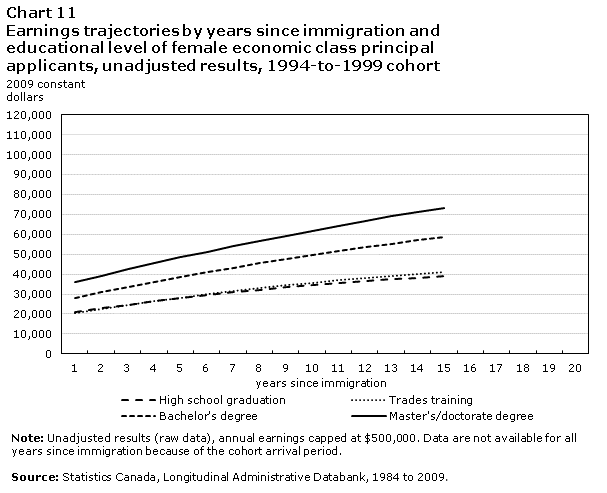
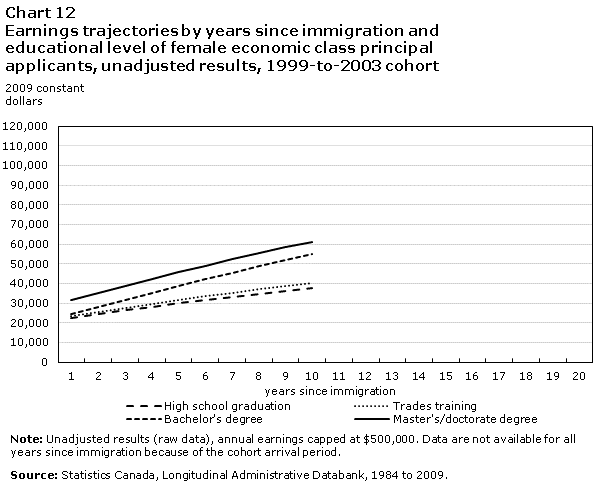
The main findings regarding female economic class principal applicants are the following:
- As with male economic class principal applicants, the earnings advantage of a bachelor's degree or master's degree/doctorate over the high-school-educated declined across cohorts. Among the 1984-to-1989 entering cohort, bachelor's degree holders had a 60% earnings advantage over high school graduates during the first five years in Canada. This figure fell continuously over successive entering cohorts, to around 15% for the two cohorts entering in the 2000s (unadjusted data, Table 4). Adjusting for differences in personal characteristics produces similar results: the earnings advantage at entry fell from 47% for the mid-1980s cohort to 19% for the early-2000s cohort.
- Also as with male economic class principal applicants, the earnings advantage to higher education in general increased with time spent in Canada, for all cohorts except the mid-1980s cohort. For example, among the early-1990s cohort, the earnings advantage to a bachelor's degree over high school rose from 37% at entry to 64% after 20 years in Canada (adjusted results, Table 5).
- As a result, after about 10 years in Canada, the earnings of the bachelor's degree holders are about the same across all entering cohorts. The more rapid earnings gains among the more recent cohorts allow them to catch up to earlier cohorts, even though their entry-level earnings are lower. For example, in the unadjusted data, after 5 to 10 years in Canada, earnings in the four cohorts, from the earliest to the latest, were $41,200, $39,400, $41,000, and $41,200. The adjusted data show similar results (Charts 13, 14, 15, and 16).
- In the adjusted data, although there is a significant decline in the earnings advantage among bachelor's degree and master's degree/doctorate holders across cohorts at entry, there has been no change in the earnings advantage among bachelor's degree and master's degree/doctorate holders after 10 years in Canada. For example, female bachelor's degree holders continue to display a significant earnings advantage (40% to 48%) over high school graduates after 10 years in Canada (depending on the cohort).
These results suggest that, as with male economic class principal applicants, short-run outcomes are not good predictors of the relative earnings position of the less educated or the more highly educated in the longer run.
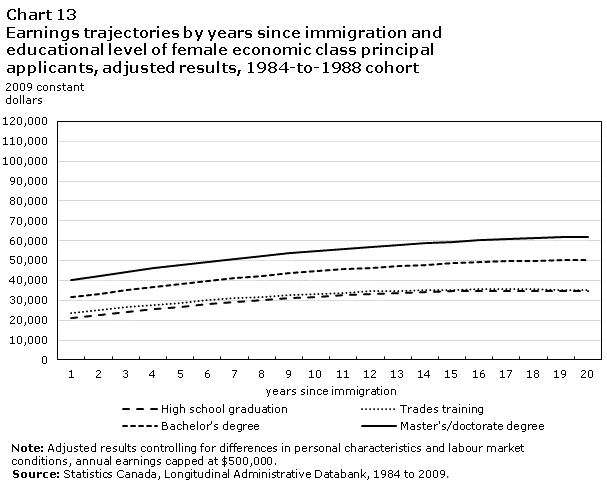


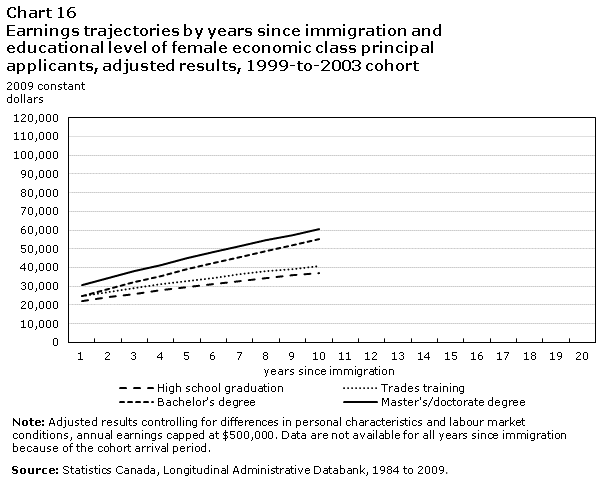
7 Results for family class immigrants and economic class spouses and dependents
The concepts behind the human capital model directly affect the selection of economic class principal applicants, who account for about 17% of all immigrants. However, the points system has indirect effects on other immigrants. There is a positive correlation between the educational attainment of principal applicants and that of their spouses. There is also a positive correlation between the educational attainment of parents and that of their children (Aydemir et al. 2013). Hence, the human capital of spouses and dependents of principal applicants is affected by the human capital requirements imbedded in the points system. The same general argument can be made regarding the family class. Generally speaking, there is a positive correlation between family members regarding human capital traits, notably education. Hence, the points system is likely to have an indirect effect on the human capital of the family class as well. Given this, the analysis is extended to include spouses and dependents of principal applicants as well as family class immigrants. In the interest of brevity, most of the analysis consists of unadjusted (raw data) results produced for male and female immigrants combined. However, some adjusted results are presented for men and women separately; they substantiate the unadjusted findings presented for both sexes.
As one would expect, the annual earnings of both economic class spouses and dependents and family class members are far below those of the principal applicants.Note 12 The average earnings of economic class spouses and dependents and family class members are quite similar (Tables 6 and 7). This is not surprising since both are, in a sense, family members of the economic class principal applicants.
In terms of relative earnings by education, entry earnings fell across cohorts for the very highly educated (master's degree/doctorate) among both family class members and economic class spouses and dependents, just as it did among principal applicants. However, readers should note that master's degree/doctorate holders are a relatively small group. The decline was less evident among the larger bachelor's degree group, however, whose entry earnings remained fairly stable across cohorts. There was some recovery in entry earnings among the latest (2004-to-2007) cohort of highly educated (bachelor's degree and master's degree/doctorate), just as there was among the principal applicants. This appears to be a robust observation. Among the highly educated, economic outcomes did improve for the latest cohort.
In terms of longer-run outcomes, annual earnings were very stable across cohorts. For example, there was little sign of deterioration in earnings after 11 to 15 years in Canada across cohorts for any education group (Tables 6 and 7) among either family class members or economic class spouses and dependents. Recent entering cohorts appeared to be doing as well as they ever did regarding earnings. For example, employed bachelor's degree holders in the family class were earning about $45,000 annually after 11 to 15 years in Canada in all three cohorts for which data are available (late 1980s to late 1990s).
Concerning the relative (to the high-school-educated) entry earnings advantage of the highly educated, the general trends are the same for the spouses and dependents of the principal applicants as for the principal applicants themselves, and hence are not repeated here (Table 8). However, things are somewhat different for the family class. The dramatic decline in the earnings advantage of the highly educated across cohorts observed among principal applicants is not seen among the family class. If anything, the earnings advantage of both bachelor's degree and master's degree/doctorate family class immigrants is higher during the latest (2004-to-2007) cohort than it was among previous cohorts. There is little evidence of any significant and continuous decline in the relative earning position of highly educated family class immigrants, in either the short run or the longer run (Table 9). Among this class, the human capital of the highly educated is as valuable among the most recent cohorts, in a relative sense, as it was for earlier cohorts. These are unadjusted results. However, even after controlling for differences in personal characteristics and economic conditions, and after conducting the analysis for men and women separately, this result holdsNote 13 (Charts 17, 18, 19, and 20 [men], and Charts 21, 22, 23, and 24 [women]). Contrary to the case of the principal applicants, there is no systematic decline in the earnings advantage of highly educated family class members.
In terms of how the earnings advantage of the highly educated changes with years spent in Canada, the pattern among the family class is very similar to that observed earlier among economic class principal applicants. That is, the longer the family class immigrants are in Canada, the greater the earnings advantage associated with higher levels of education (Table 9). For example, during the first five years in Canada, bachelor's degree graduates among the early-1990s cohort earned 27% more than their high-school-educated counterparts; after 16 to 20 years, this advantage had increased to 45%. These are unadjusted results for both sexes combined. The adjusted results display the same increase in the earnings advantage among university-educated family class immigrants, both men and women (Charts 17, 18, 19, and 20 [men], and 21, 22, 23, and 24 [women]).
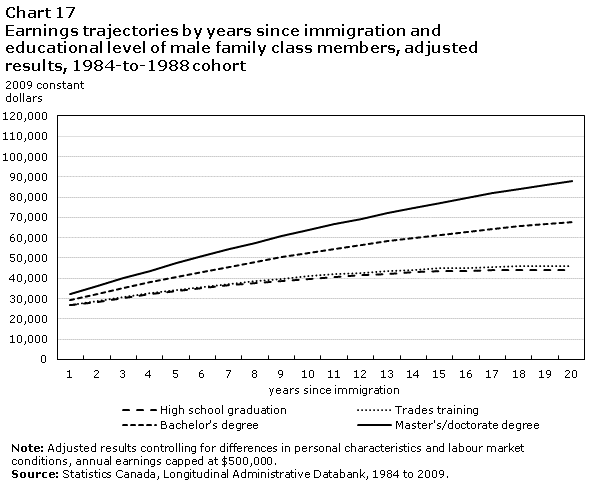

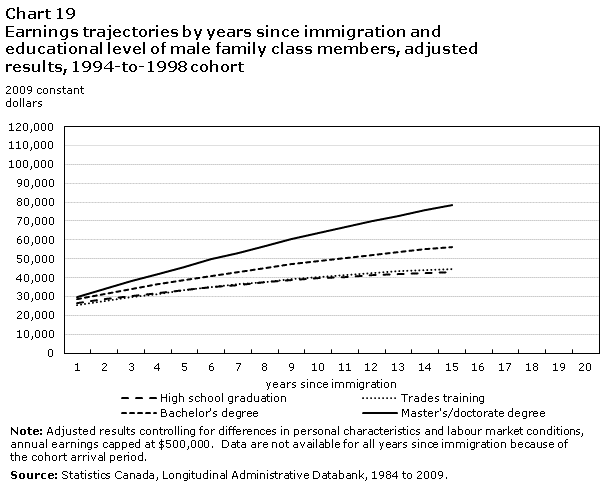



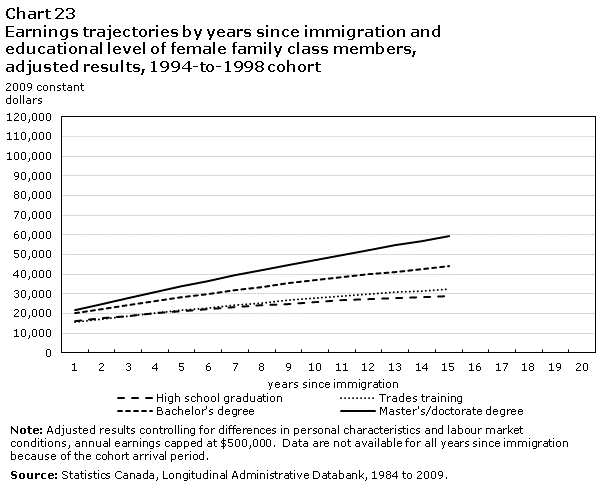
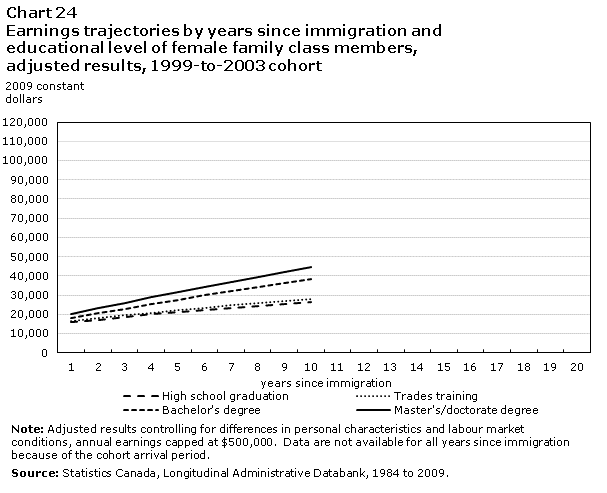
8 Summary and conclusion
The decline in the entry earnings of immigrants over the last quarter-century has been well documented. However, much of the research did not distinguish among immigrant classes. This study shows that the earnings decline was concentrated among economic class immigrants, notably the university-educated principal applicants in this class. There was little evidence of an earnings decline among the family class. Understanding these different trends by immigrant class is left to future research. This paper is concerned primarily with the relative economic outcomes of different educational levels in the longer run.
Among the early-1980s entering cohorts, university-educated immigrants had a significant earnings advantage over their less educated counterparts, both upon entry and in the longer run. Among economic principal applicants, this earnings advantage at entry was continuously reduced over successive entering cohorts and had virtually disappeared among the entering cohorts of the 2000s. The decline in entry earnings was concentrated among the more highly educated principal applicants. It was not observed among those with a trades or high school education. Furthermore, this decline in the earnings advantage of a degree was not observed among the family class, among whom a degree (relative to not having one) is as economically beneficial as it has ever been.
However, these are observations regarding short-run outcomes (i.e., during the first five years in Canada). The study finds that university-educated immigrants had a much steeper earnings trajectory than their less educated counterparts. This is a robust observation observed for virtually all groups, across all cohorts, and in both the unadjusted and adjusted results. The earnings advantage of the university-educated over the less educated (trades and high school graduates) increases significantly with time spent in Canada. In the longer run, the highly educated continue to have a significant earnings advantage over the less educated, even among the early-2000s cohort for whom the economic benefits of a degree at entry fell to virtually zero.
The empirical observations suggest that short-run economic outcomes are not good predictors of longer-run relative outcomes, at least by educational attainment. A recent PNP evaluation (CIC 2011) provided a similar lesson. While immigrants in the FSWP had lower entry earnings than their provincial nominee counterparts, their earnings were higher after five years.Note 14
Much of the existing research on immigrants’ labour market outcomes focuses on the decline in entry earnings. This paper shows that the more highly educated continue to do better in the long run, although to a lesser extent than previous cohorts.
Notes
- Date modified:
